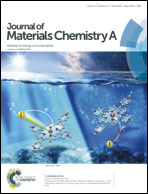One-step facile synthesis of coral-like Zn-doped SnO2 and its cataluminescence sensing of 2-butanone†
Abstract
Self-assembly of one-dimensional nanoscale building blocks into functional 2-D or 3-D complex superstructures is of great importance. In this work, we have developed a facile hydrothermal method to synthesize coral-like Zn-doped SnO2 hierarchical structures assembled from nanorods. XRD, SEM, TEM, XPS, FTIR and N2 adsorption–desorption were used to characterize the compositions and microstructures of the samples obtained. The growth mechanism was also explored by investigating the samples synthesized at different reaction times. As sensing materials for a cataluminescence (CTL) gas sensor, this coral-like Zn-doped SnO2 demonstrates excellent CTL behaviour (that is, high sensitivity, superior selectivity to 2-butanone compared with other fifteen kinds of common volatile organic compounds (VOCs) as well as a fast response and recovery). Three different Zn/Sn molar ratios of SnO2 samples were tested under the same conditions to prove the effect of Zn doping concentration on the sensing performance. We further studied the analytical characteristics of the CTL sensor based on 1 : 10 Zn-doped SnO2 sensing materials for 2-butanone under the optimal experimental conditions. The linear range of the gas sensor was 2.31–92.57 μg mL−1 (R = 0.9983), and the detection limit was 0.6 μg mL−1 (S/N = 3).


 Please wait while we load your content...
Please wait while we load your content...